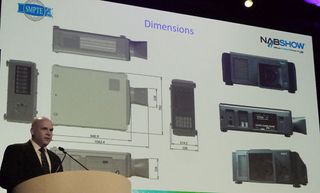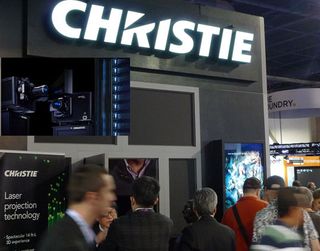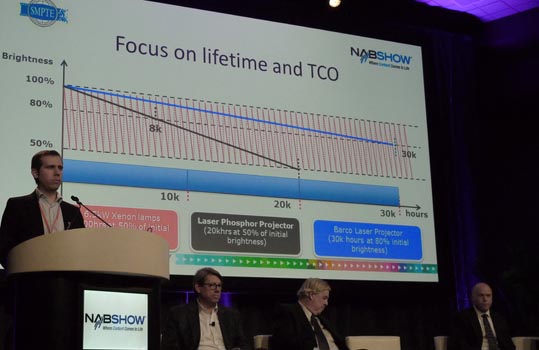The Cinema Summit, held annually on the eve of the NAB show in Las Vegas, is always a great place to see we’re headed for high end, large venue video projection– for the cinema market of course but also for all down-stream (and some up-stream) AV markets. Sandwiched tightly as it is between CinemaCon in late March (where commercial movie theater owners come to see the latest technology) and NAB in April, it’s a nice mix of in-depth technical presentations on the state of projection technology today and lots of “what does the future hold” panel sessions. But never in recent memory has the Cinema Summit seen the launch and even a shootout of sorts of actual products– and the fact that those products are large venue projectors is important. This Cinema Summit that wrapped last night, on the eve of the NAB Show, saw a major technology milestone: the commercial launch of the first real, ready to ship, high lumen Laser projectors from industry heavyweights Barco, Christie, and NEC– and not just for cinema but for the highest echelons (simulation and very large venue) for the pro AV market as well.
To set the stage for this week’s Cinema Summit we have to look at important recent developments and one big trend. At CinemaCon in Las Vegas late last month, the theater owners in attendance were reminded that most of the most profitable movies in 2013 were 3D movies. And at the 2014 Academy Awards, the big winner Gravity was a 3D movie (Gravity). The fact that the rollout of the first HFR, 3D Hobbit movie saw some speed bumps seemed ancient history early in 2014. Indeed, after the release of the 2nd Hobbit installment, The Hobbit: The Desolation of Smaug, in December 2013, also in HFR but with no HFR-related marketing message attached, there was virtually no HFR controversy or even comment from pundits or public. So all is back on track, and all is fine in the world of the commercial movie theater, right?
What’s now perhaps not the sole cause but a key driver in the launch of entirely new projection systems– not just a tweaking of existing systems like HFR attempted to do– is the growing consensus that 3D in the movie theater is not wowing audiences enough–specifically U.S. audiences. The culprit? The answer is not simple, but the most likely suspect– if you boil down most of the clues– is the huge light drop off as current 3D set-ups filter left and right eye images through the system, resulting in much darker images on the screen in a 3D screening as compared to 2D projection.
The Hollywood studios and NATO (National Association of Theater Owners) members went “all in” with 3D for movie theaters over the past five years, to differentiate the commercial movie theatre experience from the home theater experience. But when the theater owners at CinemaCon were told last month that the most profitable movies in 2013 were 3D movies, that sidestepped the fact that the big Hollywood studios are putting out almost all their tent-pole and franchise movies in 3D, so it’s a difficult to argue that their success is related to 3D. And to gauge the marketing success of 3D, you have to distinguish between the international and domestic U.S. market. Because in non-U.S. markets the conversion to digital has been done more recently (with the latest gear) but more importantly with a 3D bias built in– many theaters in important new markets like China are getting 3D-only releases of Hollywood tent-pole movies. But in the U.S. the theater owners have been successful at convincing the Hollywood studios to let them screen both 3D and 2D versions of movies.
Recent data from Morgan Stanley paints a picture that alarms Hollywood: 3D movies are losing box office depth in the U.S. Morgan Stanley’s Benjamin Swinburne said in February that he expected 3D showings to account for 39% of the total box office for films released in 3D in 2014, the lowest ratio in seven years and down from 42% in 2013 and 53% in 2012. This translates as: there are now lower sales of the premium-priced tickets for 3D movies. There is shrinking “uptake” on 3D, less margin in the U.S., even though many 3D movies are finding success in the market generally.
At the Cinema Summit at the NAB show this week, all the big technology players were assembled again, to explore in two full days of sessions: how can we make the cinema experience better? What production or projection tools are the right ones, to help differentiate the theatrical experience from an increasingly improving home cinema experience? There were dozens of ideas, technologies and trends explored at the Cinema Summit, but none as important as the introduction of the Laser projector, via a special Saturday session and demo, and also with Laser projection demos on both the NAB show floor and at a cinema in Las Vegas set up to showcase the new technology.
The first shots were fired on Saturday, in the session “Laser Illuminated Projectors: What's New and When Will They Arrive? Bill Beck, President of BTM Consulting moderated panelists Pete Ludé, CTO of Mission Rock Digital; Goran Stojmenovik , Product Manager Laser Projection, Barco; Richard McPherson of NEC Display Solutions; and Don Shaw, Senior Director of Product Management for Entertainment Solutions at Christie.
The panel was straight forward– not your typical panel involving a lot of speculation and vague talk of coming solutions. It was three major projector manufactures explaining their new Laser projectors. And surprisingly, this was not a “me too” exercise: each company is launching a very different kind of Laser projector and/or 3D solution into the market this spring.
Pete Ludé was wearing his LIPA (Laser Illuminated Projection Association) hat– he is the current president of LIPA– and gave an update on the regulatory issues for laser projectors. Over the past few years the industry has been waiting to see if FDA regulations about use of laser devices were going to hold back the technology. Complicating that is the fact that currently the FDA says that laser projectors fall under their rules for “Laser Light Show Variance” i.e. they have considered laser illumination for projectors as lights, not lamps. This has not been a deal-breaker for high lumen laser projectors as it’s possible today to get the “variance” with a bit of paperwork from the FDA to install a projector, but it’s been a speed bump. But Ludé explained that major news broke just weeks ago: the IEC approved on March 16th, 2014 the new Edition 3, for the International Standard, that is now scheduled for publication April 30. This new standard carves out a separate category for laser projectors, and treats them as lamps. This will create smooth sailing for high lumen laser projectors going forward.
So cut to the chase– what Laser projectors do Barco, Christie, and NEC have to offer the market? And what did we actually see on the screen at NAB?
Barco’s Goran Stojmenovik explained in detail the company’s new Barco DP4K-60L, RGB-laser illuminated 60K lumen cinema projector. This is a 6-P laser configuration, that’s coupled with a Dolby 3D color separation system. Barco is stressing a one-projector 3D solution (left and right eye sequential images). This projector has an estimated lamp life of 30,000 hours, and it can show 4K content at up to 60 fps and 3D movies in full 4K. Barco is also emphasizing the one-projector, “no-fiber” connections setup (between two separate projectors, i.e. as Christie is doing) for 3D, hoping that the simpler approach will win market share for cinema by allowing theaters to replace a dual-stacked setup of xenon-based digital cinema projectors with this one projector– and still offer double the 3D brightness of those xenon-based projectors. A single DP4K-60L projector can do up to 24 meter wide screens with 7fL 3D, with 1.8 gain; or up to 17 meter wide screens with 14fL, with 1.8 gain.
Goran Stojmenovik, Product Manager Laser Projection, Barco, explains Total Cost of Ownership calculations comparing Xenon lamp projectors, Phosphor laser projectors, and RGB Laser projectors.
Barco has already secured sales of some DP4K-60L projectors to CineMark, and Santikos, in the U.S., and Kinepolis in Europe. To demo the new product, Barco held a special demo on Sunday night, on the eve of the show floor opening of NAB– a special screening at the Cinemark Century 16 Southpoint theater in Las Vegas. Ted Schilowitz, formerly of Red, and Barco’s new “CinemaVangelist” hosted the even, that according to Barco was done “in a proper movie theater” to better showcase the projector.
Interestingly, the Barco demo at the Cinemark theater included both 2D and 3D content– all from a single projector. The movie and other content clips shown in 2D were put up at a very impressive brightness– 17fL on the approximately 50’ wide, 1.8 gain screen (MDI)– and this with the projector light source dialed down to only 30% output. Both the room size and the screen size at the Barco demo were significantly larger than those in Christie's demo both at Christie's presentation at the Cinema Summit and the Christie booth on the NAB show floor Monday, so real A/B comparisons were difficult. It's interesting that for the 3D screening Barco technicians said that they were running the light source at about at about 50% power and achieving 14fL on the white screen for their demo. Barco will be doing a few more demos at the Cinemark venue during the NAB show.
You would expect NEC to come in to the market from a different angle. Compared to the other two DLP Cinema licensees Barco and Christie, NEC has always been more keen on working the cinema market for smaller more nimble projectors. And indeed NEC is launching a Laser projector that is very different that Barco’s and Christie’s bigger guns. At the Laser projector panel session on Saturday, Rich McPherson of NEC gave details on NEC’s new Laser Phosphor Projector. This projector is an attempt by NEC to come in under the FDA’s regulatory radar, and with a less expensive solution for high lumen projection. It can do 14fL @1.8 gain on an 11 meter wide screen. It has a lamp life of 20,000 hours. And because it’s based on the phosphor laser, not the RGB laser system, the FDA does not regulate its use in theaters. McPherson did not talk about 3D in his presentation, but stressed the compact size of the projector, its lower cost, and its regulatory-friendly status. And he said that he thinks NEC will ship “a few hundred” units this year.

Richard McPherson of NEC Display Solutions stressed the compact size of the new NEC Phosphor Laser projector, its lower cost, and its regulatory-friendly status. And he said that he thinks NEC will ship “a few hundred” units this year.
Don Shaw of Christie steered the focus back to 3D, with his demo of the company’s new 2-projector, laser illumination offering. Utilizing six specific primary colors, the new Christie D4K2560 3-chip DLP projector also uses the Dolby 3D color separation system. But Shaw said that doing sequential left/right eye 3D projection is not ideal and is in fact the source of some consumers’ discomfort with 3D. So Christie is suggesting that 2-projector 3D is optimal.
“All the lasers in use all the time”, is the best way to go, Shaw said. And he explained that this system allows for an impressive 42-45% light efficiency (amount of light leaving the “lamp” that actually makes it through the 3D filtering to land on the screen, compared to about 13%, on a white screen, with a current xenon lamp 3D single projector configuration) and achieving 3000:1 contrast ratio (compared to a 2000:1 contrast ratio in current xenon lamp-based 3D). Shaw also said that this system eliminates the need for silver screens and their problems with hot spots, uniformity, and exacerbating of the speckle issue in laser projection.

- Christie scheduled demos at their booth of its 6P laser throughout the NAB show, showing both standard 24 fps (from Avatar), and 48fps (from Hobbit: Desolation of Smaug) clips on a 17' 1.0 gain white screen (8000 lumens from the 2-projector 3D set up, or 14fL).
Shaw said that Christie will ship some several dozen Laser projectors this year. Interestingly, some units are going to the pro AV market according to Shaw.
Don Shaw demo’d the projectors for the audience at the Cinema Summit, with clips from both Hobbit II, and Avatar. The dual projector 3D setup put up 15,000 lumens on the white screen (14 fL on the 27 ft wide screen in the room). The screening was impressive, and the increased lumens on the screen brought the 3D out from the Xenon shadows. (Note: if this had been a 2D Laser projector demo, they could have put up 60-70K lumens on the screen with just one projector– so you can do the math on the 3D light path.)
Christie is continuing actual demos of the system at their booth at the NAB show this week. It was interesting to view the demo in the booth Monday morning, after having seen it in a different room at the Cinema Summit 2 days earlier. What impressed me in the Monday booth demo was the clear difference in image quality between the two movie clips that Christie showed. It was harder to put my finger on it in the Saturday Cinema Summit demo– but it was crystal clear in the booth demo: the Avatar clip was shown in 24fps and the specific clip involved a lot of motion and action. And while the image was impressively bright with deep blacks, there were definite motion artifacts– the classic result of action filled 3D capture at slower frame rate– laser projection or no laser projection. (Ironically, at last year's NAB show, Christie's 3D demo– with xenon projectors– featured James Cameron talking about the benefits of HFR). But the Hobbit clip shown was in 48fps– and it was wonderful. No motion artifacts, as could be predicted. This really brought home to me that HFR is a real upgrade in imaging– you just have to have all the other elements in place to really show it off.
The cost of the new high lumen Laser projectors? Not cheap. Think multiples, not percentage increases, above the current crop of DLP Cinema projectors. But the TOC (total cost of ownership) math, based on hugely increased lamp life of the laser “lamp”, works in their favor. How much in their favor? That’s where a lot of variables come in– and where the different offerings from the different companies start segmenting out. To do 3D on one screen in one theater, the one-projector 3D system would be less expensive than the the two-projector set up, right? The engineering does not work out that way, since you need more lasers in the one projector for the single-projector solution– and the lasers are the most expensive part of the system, not the projector head. (The Barco projector uses two sets of RGB primary lasers, to do the sequential imaging). But to complete any TOC evaluation of one system vs. the other, you also have to take into account other factors, such as what kind of cooling is needed, space needed for the installation, what servers are involved etc. (Barco with this introduction is also suggesting its Alchemy server, but says that it will work also with Doremi and other servers in use in the market.)
Will NATO members jump on board in big numbers this year? Not a lot will. But enough will, to start creating real buzz. The genie will be out of the bottle, and (unlike with HFR) the upside will be stunning and indisputable in terms of improved image. And I do think the AV world–designers of simulation systems, and very high end stagers– will play an outsized role in this technology rollout right out of the gate.
Probably the one interesting part of the new Laser projection landscape that was not discussed in the panel Saturday– or anywhere else at NAB– is IMAX’s coming unveiling of Laser projection to replace IMAX theaters’ legacy 1570 film projectors. How does that fit into the story? Good question, but one that has analysts scratching their heads. (David Keighley, Executive VP of IMAX, was on Michael Karagosian’s separate panel at the Cinema Summit Saturday, “The Future of Cinema”, but offered no hints about the coming IMAX Laser projectors.)
Since IMAX bought the Kodak 3D patents, they are apparently lighting out on their own, with their own exclusive, digital 3D 2-projector/polarizing filter regime, that no one has seen. Whatever IMAX does– and they’ve said they will unveil the new system this year– it can only be huge boost to all things high-lumen, not just 3D. A boost that will dovetail nicely with what the big projector manufacturers are doing this year– more quickly than anyone would have predicted when high lumen Laser projection was just a trade show novelty.










